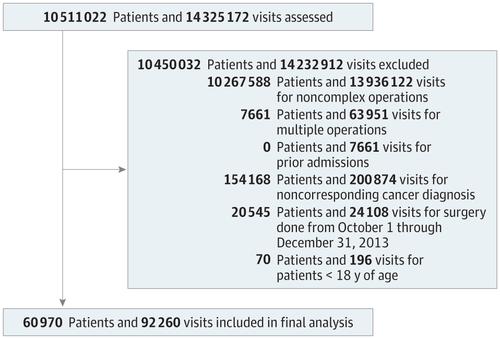JAMA Surgery ( IF 16.9 ) Pub Date : 2018-08-01 , DOI: 10.1001/jamasurg.2018.0380 Syed Nabeel Zafar 1 , Adil A. Shah 1 , Hira Channa 2 , Mustafa Raoof 3 , Lori Wilson 1 , Nabil Wasif 4

|
Importance Increasing regionalization of cancer surgery has the inadvertent potential to lead to fragmentation of care if readmissions occur at a facility other than the index hospital. The magnitude and adverse effects of readmission to a facility other than the one where the surgery was performed are unclear.
Objectives To assess rates of readmission to nonindex hospitals after major cancer surgery and to compare outcomes between index and nonindex hospital readmissions.
Design, Setting, and Participants In this multicenter, population-based, nationally representative study of adult patients undergoing a major cancer operation (defined as esophagectomies or gastrectomies, hepaticobiliary resections, pancreatectomies, colorectal resections, or cystectomies), retrospective analyses were performed using the Nationwide Readmissions Database (admissions from January 1 through September 30, 2013). Descriptive analyses were performed to determine 90-day readmission characteristics, including timing, cost, and outcomes. Adjusting for clustering by facility, the study used multivariate logistic regression to identify factors associated with nonindex vs index readmissions. The study also used regression models to identify differences in mortality, major complications, and subsequent readmissions between the 2 groups. Data analysis was performed from January 1 through December 31, 2013.
Exposures Readmission to index vs nonindex hospitals (defined as any hospital other than the hospital where the major cancer operation was performed).
Main Outcomes and Measures Proportion of 90-day readmissions and nonindex readmissions after major cancer surgery, factors associated with nonindex readmissions, and difference between in-hospital mortality, hospital costs, and subsequent readmissions for patients admitted to index vs nonindex hospitals.
Results A total of 60 970 patients were included in the study (mean [SD] age, 67 [13] years; 7619 [55.6%] male and 6075 [44.4%] female). The 90-day readmission rate was 23.0%. Of the 13 695 first readmissions, 20.1% were to a nonindex hospital. Independent factors associated with readmission to a nonindex hospital included type of procedure, comorbidities (OR, 1.40; 95% CI, 1.15-1.70), elective admission (OR, 1.21; 95% CI, 1.06-1.37), discharge to a nursing facility (OR, 1.20; 95% CI, 1.07-1.36), and surgery at a teaching hospital (OR, 1.16; 95% CI, 1.00-1.34) (all P < .05). After risk adjustment, patients readmitted to nonindex hospitals had 31.2% higher odds of mortality (odds ratio, 1.31; 95% CI, 1.05-1.64) and 27.3% higher odds of having a major complication (odds ratio, 1.27; 95% CI, 1.14-1.42). Subsequent readmissions and hospital costs were not different between the 2 groups.
Conclusions and Relevance Approximately one-fifth of readmissions were to a nonindex hospital and were associated with higher mortality and morbidity than readmission to index hospitals. Factors that influence nonindex readmissions have been identified to target interventions.
中文翻译:

大型癌症手术后索引医院和非索引医院的再入院率和结果比较
重要性 如果在索引医院以外的其他机构再次入院,则癌症手术区域化的增加会无意间导致护理分散。目前尚不清楚再次入院的设施的大小和不良影响,而该设施不在进行手术的地方。
目的 评估重大癌症手术后非索引医院的再入院率,并比较索引医院和非索引医院的再入院率。
设计,设置和参与者 在这项以人口为基础的全国性多中心,全国性研究中,正在接受重大癌症手术(定义为食管切除术或胃直肠切除术,肝胆管切除术,胰腺切除术,结直肠切除术或膀胱切除术)的成年患者,使用全国再入院数据库进行了回顾性分析( 2013年1月1日至9月30日)。进行描述性分析以确定90天的再入院特征,包括时机,成本和结果。根据设施进行聚类调整后,该研究使用多元逻辑回归分析来确定与非索引对索引再入院相关的因素。该研究还使用回归模型确定了两组之间的死亡率,主要并发症和随后的再次入院率之间的差异。
Exposures Readmission to index vs nonindex hospitals (defined as any hospital other than the hospital where the major cancer operation was performed).
Main Outcomes and Measures Proportion of 90-day readmissions and nonindex readmissions after major cancer surgery, factors associated with nonindex readmissions, and difference between in-hospital mortality, hospital costs, and subsequent readmissions for patients admitted to index vs nonindex hospitals.
结果 研究共纳入60 970例患者(平均[SD]年龄,67 [13]岁;男性7619 [55.6%],女性6075 [44.4%])。90天的再入院率为23.0%。在13 695例首次再入院中,20.1%进入了非索引医院。与非索引医院再次入院相关的独立因素包括手术类型,合并症(OR,1.40; 95%CI,1.15-1.70),择期入院(OR,1.21; 95%CI,1.06-1.37),出院护理(OR,1.20; 95%CI,1.07-1.36),以及在教学医院进行手术(OR,1.16; 95%CI,1.00-1.34)(所有P <.05)。经过风险调整后,重新入住非索引医院的患者的死亡率更高(比值比为1.31; 95%CI,1.05-1.64)和37.3%的具有重大并发症的可能性(比值比为1.27; 95%CI, 1.14-1.42)。两组的随后再入院率和住院费用没有差异。
结论和相关性 大约五分之一的再入院是非索引医院的,与死亡率和发病率相比,再入索引医院的死亡率和发病率更高。已经确定了影响非索引收录率的因素以干预为目标。


























 京公网安备 11010802027423号
京公网安备 11010802027423号